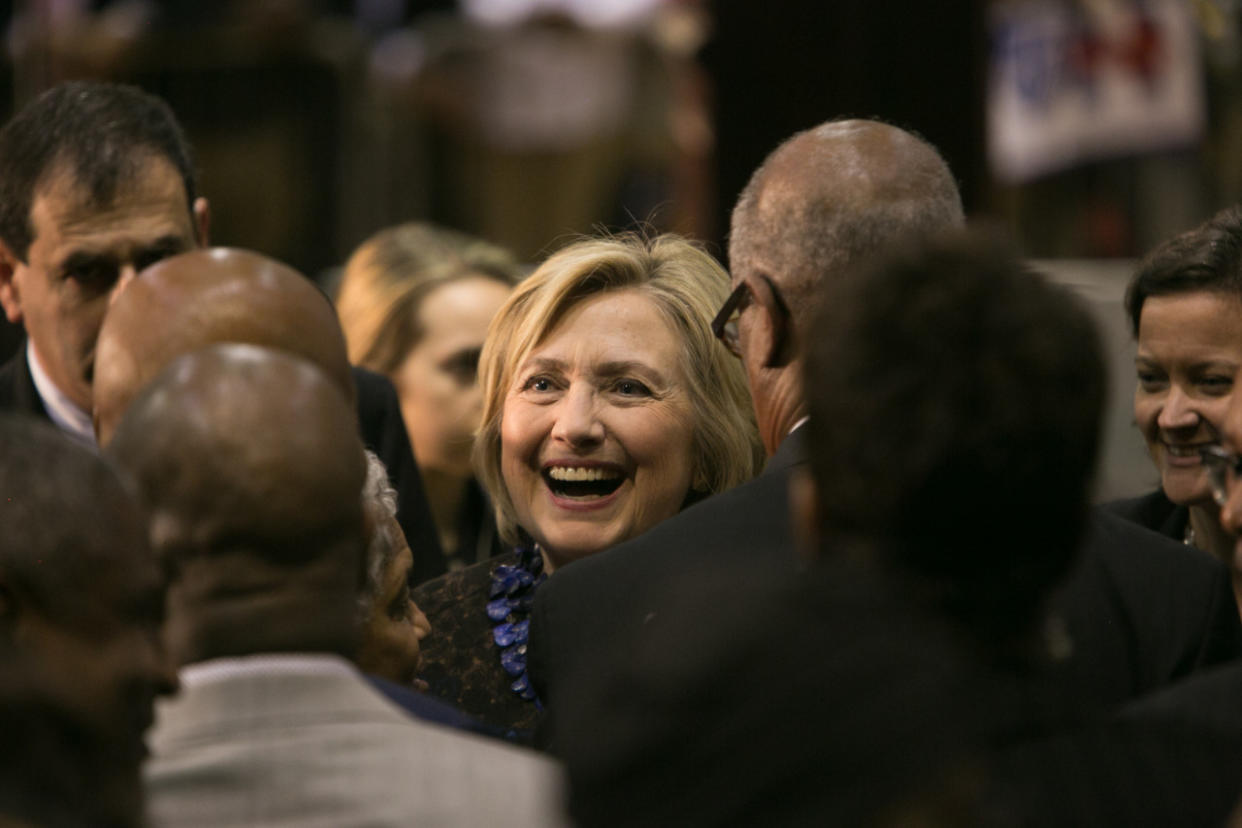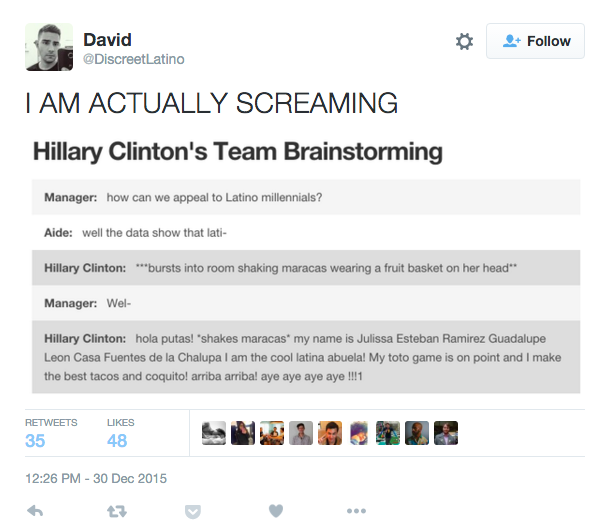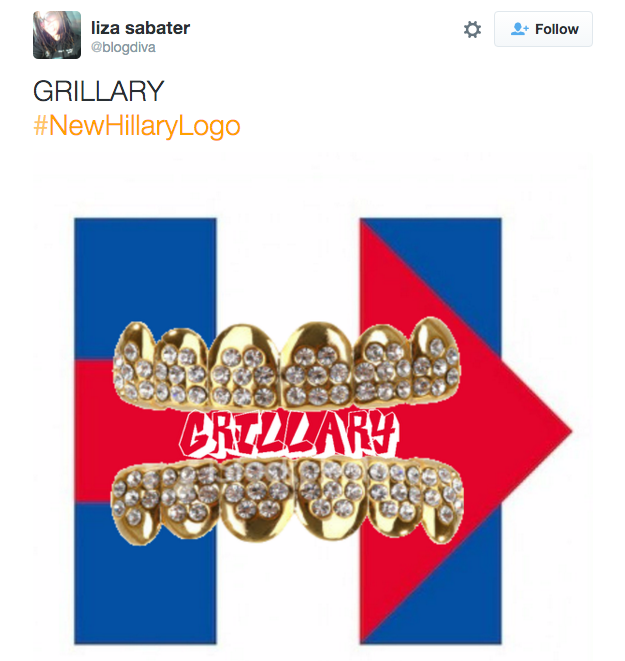Why Hillary Clinton’s online persona doesn’t connect with minorities

(Photo: Melina Mara/The Washington Post via Getty Images)
On October 13, Saturday Night Live kicked off its show with a parody of the most recent Democratic debate. It was back when the stage had more candidates; Vice President Joe Biden had yet to decide whether he’d run for president and Bernie Sanders was having a moment. After the Vermont senator (played by Larry David) rattled off a few nonsensical promises, a worried Hillary Clinton (depicted by Kate McKinnon) interrupted:
“I’m not losing, am I?” she asked the audience with a furrowed brow. “I mean in 2008 of course I lost, I was running against a cool black guy. But this year I thought I got to be the cool black guy!”
Though the mere suggestion that a 68-year-old woman who regularly wears pantsuits and watches The Good Wife could somehow be this election’s “cool black guy” earned laughs from the crowd, it also hinted at what has lately been an identity struggle for Clinton’s campaign. The former secretary of state has built an undeniably savvy social media team that has mastered the art of shade, successfully co-opted the feminist declaration “yas queen,” and scheduled well-timed selfies with Kim Kardashian. But at the same time, her campaign has made tellingly awkward attempts at reaching and relating to young minority voters.
In early December, for instance, Clinton updated her social media accounts’ profile photos with a redesigned version of her campaign’s ubiquitous H logo, featuring an illustration of civil rights pioneer Rosa Parks. Though meant to commemorate the anniversary of Park’s civil disobedience, it drew criticism because Parks appeared to be sitting at the back of the bus. Then there was the infamous listicle, “7 Things Hillary Clinton Has in Common With Your Abuela,” (Spanish for grandmother) that appeared on Clinton’s website shortly after the her daughter, Chelsea, tweeted she was pregnant with a second child. It caused intense backlash in the Latino community on Twitter, where the hashtag #NotMyAbuela began trending worldwide, and people shared stories of their immigrant grandmothers’ hardships (far from the life experience of Clinton). Just two days later, her Twitter avatar was changed to yet another paint-by-numbers H logo, this time as a Kwanzaa candleholder. Black Twitter promptly clapped back with a #NewHillaryLogo campaign, that included memes depicting other blatantly pandering redesigns of the image. Her Twitter avatar was quickly replaced.

A parody of Drake’s 2013 album, “Nothing Was the Same.” (Screen shot: via @awwwchris)
This unfortunate series of events have led some observers to call out Clinton for her endless thirst for attention or to charge that Clinton is sidestepping actual issues with cheap attempts at relating to minorities. But the Clinton team’s real problem in online outreach is one of tone. Slate’s Amanda Hess rightly characterizes the candidate’s online presence as less a reflection of Clinton than a series of accounts “written in the voice of a Hillary Clinton enthusiast eager to build an online fandom in her idol’s image.” This approach successfully walks the line between cultural appreciation and cultural appropriation, at least with respect to certain Internet-savvy and feminist subcultures. And even when the campaign got too enthusiastic with emoji, it was far from offensive.
But while this fawning strategy can work with the right audience (the one that made superstars of Lena Dunham and Amy Schumer), it doesn’t ring true for everyone. Clinton’s team understands that by virtue of her longtime prominence as a woman in American politics, she is a fixture of the gender rights movement. Her campaign has drawn from her extensive record of accomplishments in this area, including her famous 1995 speech at the United Nations Fourth World Conference on Women, where she declared that “women’s rights are human rights.” Even if Clinton’s now enthusiastic support for gay marriage was somewhat belated, it fits well with her persona as a politician.
But over the course of her career as a politician, she has been far less outspoken on immigration and criminal justice reform, issues that are currently of intense interest among young minority voters. Clinton is, in fact, leading Sanders in the polls among Latinos and African-Americans, in part because of the considerable resources her campaign has devoted to these groups. Her campaign has hired bilingual strategists for Spanish-language content, and Clinton earned headlines when she used the Spanish word “basta” (enough) in reference to Donald Trump. But there is a persistent sense that she fails to connect with them emotionally. Even if one of her Latina staffers admires her boss enough to vaguely compare her to her abuela, it’s much harder to convince the larger Latino public that Clinton comes even close to comprehending what it’s like to be Hispanic in America. The same can be said when it comes to Clinton’s standing in the African-American community, as evidenced by her awkward confrontations with Black Lives Matter protesters earlier in the year. The otherwise successful Clinton fangirl/boy voice should think twice about venturing into the dicey subjects of minority rights or immigration reform, lest it come off sounding like it belongs in the clueless category of brands that say bae.

(Screen shot via @DiscreetLatino).
The Democratic candidate would do better to take a page out of the Sanders’ playbook. The Vermont senator’s strategists, understanding that he will never pass for a “cool black guy,” has settled for the closest thing to it: having public, taped conversations with cool black guys. In early November, for instance, he visited the SWAG barbershop in Atlanta for a long, substantive conversation with civil rights activist and rapper Killer Mike. Just a single snapshot of the 74-year-old Sanders sitting across the table from the respected hip-hop artist, who has compared the cops in the ghetto to the Gestapo, was enough to spur headlines and spark fervor among Twitter’s young, black users. Even though the interview was staged, it demonstrated an earnest effort by the Sanders’ campaign to speak to a demographic that often feels marginalized.

(Screen shot via @blogdiva.)
Sometimes that’s all it takes to win the interest of a person who doesn’t directly relate to you. At the very least, it’s better than forcing that connection in a listicle titled “Hillary Clinton’s 25 Favorite Scenes from Spike Lee Joints.”

